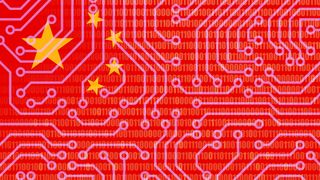When the Cold War ended, many envisioned a new "end-of-history" era where almost every nation would embrace free trade and comparative advantage — producing what a nation is good at and importing the rest.
Alas, China and President Xi Jinping had other plans: to dominate the world in a wide array of technology-based industries, both current and emerging, and to use a wide array of economic and trade practices to achieve that goal. And that means Australia — and its core allies and partners — require a new framework for economic and technology statecraft vis-à-vis China.
China never meant to be a free trader or follow WTO rules. China used the WTO to gain free access to foreign markets, especially US markets, while actively engaging in trade practices that breached WTO norms.
When China was admitted to the World Trade Organization (WTO) in 2001, a mercantilist fox was let into the free-trade henhouse. China never meant to be a free trader or follow WTO rules. China used the WTO to gain free access to foreign markets, especially US markets, while actively engaging in trade practices that breached WTO norms. This included massive subsidies for domestic producers and forced technology transfers as a condition of market access — neither of which can be effectively prosecuted under WTO rules. The hope for China to embrace a rules-governed, market-based global trade system will not materialise as long as the Chinese Communist Party is in power.
So, what does China want? Wealth and power, as argued by China scholar Orville Schell in his book of the same title. For China, the two are inextricably linked and come from winning the global competition for technologically advanced industries. This has long been an ambition of China — since Beijing’s 1999 "Go out" strategy, and their 2006 National Medium- and Long-Term Plan for the Development of Science and Technology, which identified over 200 technologies China wanted to master.
Since he came to power in 2013, Chinese President Xi Jinping has consistently trumpeted a goal of continuing to make China the “master [its] own crucial technologies.” This was strengthened in 2015 by Xi’s “Made in China 2025” strategy, which set out numerical targets for China’s level of self-sufficiency in leading industries. In this vision, Chinese firms would produce virtually all technology goods and services for Chinese consumers, and then, through programs like the Belt and Road Initiative, export the work of their now-competitive domestic firms.
These ambitions have been backed by various government tactics — from restrictions on foreign firms’ market access and widespread intellectual property theft to forced technology transfers, subsidies for Chinese firms and far more. By state dictate, subsidy, and closed markets, China has worked to develop competitive or dominant domestic capacity in a variety of advanced industries. Beyond building the world’s largest commercial shipbuilding industry, it is heavily influential in telecommunications equipment, solar panels, drones and steel. And it is seeking global leadership in an array of emerging technologies, including quantum computing, batteries, robotics, artificial intelligence, biotechnology and electric vehicles.

China uses this suite of policies to create trade dependencies within many industries to provide Beijing with protection against trade retaliation. It used predatory practices to reduce the non-Chinese global supply of rare earth minerals — subsidising its own producers to gain a majority market share, attracting foreign firms with cheap labour and lax laws, before forcing those foreign companies to partner with Chinese firms to induce knowledge transfers. In 2011, China shrank raw rare earth mineral exports (inflating international prices) so that its fledgling firms could shift into exporting more refined, higher-value rare earth products and outcompete non-Chinese firms.
For example, by massively subsidising manufacturing in China — including through currency manipulation to keep export prices low, outright subsidies, and closed markets — China not only built up its own industries, but weakened those of its competitors, leading to significant manufacturing output and job loss, especially in the United States. Indeed, it induced the offshoring of critical manufacturing sectors to China, as many countries saw when they needed to obtain surgical masks and ventilators during the COVID-19 crisis.
China has strengthened its position — using the success of its government-aided dominance of industries to power a shift towards higher-value, more innovative products. A recent ITIF study looking at a variety of innovation indicators (e.g., R&D, patents, tech industry output) found that from 2010 to 2020, China’s innovation and advanced-industry capabilities went from approximately 58 per cent to 75 per cent of US capabilities on a proportional basis (accounting for the size of its economy, population, etc.). Moreover, on an absolute basis (e.g., amount of R&D, number of patents, etc.) China had 139 per cent of US innovation capabilities and outputs by 2020. Not only does China now have greater innovation capabilities than the United States, but its per-capita output is catching up as well.
China, however, does not want to be autarkic in all goods and services. Far from it. It focuses on exporting complex manufacturing goods while importing commodity goods, ideally in such quantities as to create foreign dependencies. That is why China has become the go-to market for many nations seeking to export raw materials, risking turning these nations into dependent vassal states, worried China could cut off their exports at any time. In the words of Xi himself, China wants to have coercive leverage through “international production chains’ dependence on China”.
As such, nations like Australia need to structure their trade in a way that not only maximises their economic welfare but reduces their dependency on China.
What should Australia do?
A decade ago, US and Australian policy elites ignored any claim that China was a threat, believing it was simply a developing nation seeking greater wealth. Today, some free traders[TB1] continue to deny the harms China’s policies have caused the United States and others, arguing that only by remaining engaged with China is there any hope of them moving in the globalist, market direction. But these voices are no longer front and centre in Washington, as evidenced by the Biden administration’s recent suite of high-tech export restrictions to China and the creation in the House of Representees of a new Select Committee on China.
China is equally worried about the West cutting it off from advanced technologies, as President Biden has done with advanced node semiconductor equipment. That is why allies all need robust domestic advanced industry policies, ideally coordinated among themselves, in order to advance their collective lead over China.
But while free traders understate the threat, some US China hawks overstate it, or at least overstep in terms of the response. Many now seek full decoupling, much that is often not aligned with actual risks. They would ban the Chinese social media app TikTok, end all US financial investments in China, significantly limit US company investments in China — even if this was done unilaterally — and cut off a wide swath of exports. Such a path might be geopolitically satisfying, but it risks cutting off America’s nose to spite its face. Unilateral non-military export controls often backfire because other advanced nations keep exporting to China and take away US market share or Chinese firms turn inward to buy what they need.
Indeed, preventing American or Australian companies from selling non-sensitive goods to China cedes the Chinese market to US competitors, reducing US companies’ revenues while increasing Chinese companies’ revenues — weakening the US and Australian economies and hurting jobs while helping their competitors. If Google does not sell its services in China, Baidu and other Chinese internet companies are stronger, not only in China but in many other nations as well, while Google, American workers, and the US tech economy are weaker. If Hollywood walks away from China, more non-US foreign and Chinese movies will be shown there, and there will be significantly fewer jobs and export earnings in America. For American companies, there will be less R&D and investment, and lower US global market share. For Chinese companies, the opposite will be true, because they will step into the vacuum. How can that possibly be in the US national interest?
Fortunately, there is a happy medium between the business-as-usual camp and the aggressive decouplers. This could be termed ‘strategic decoupling’. In other words, allied government policymakers need to work cooperatively to identify where China holds critical leverage over our economies and work to reduce that leverage. Who cares if China dominates the furniture industry, the toy industry, or the footwear industry? If China decided to cut off these exports as punishment and leverage, it would have little effect, other than kids might not have as many presents at Christmas. But it does matter if China cuts off exports of active pharmaceutical ingredients, rare earth minerals or batteries.
Allies need to start by jointly mapping such critical dependencies, including how robust supply chains are and what flexibility producers have to quickly shift production from one product to another. At the same time, allies need to work together to build alternative production capacity if needed. The capacity doesn’t have to be in every country, but at least one of the core allies needs to be able to produce it. This will require explicit reshoring programs, ideally involving some subsidies for companies to bring back production, as Japan has recently instituted.
The recent alteration of the global geopolitical environment has brought into stark reality the weaknesses of long-running economic shifts (and proactive actions) that have favoured China — giving it market dominance and trade leverage throughout industries and supply chains.
Leverage works both ways. China is equally worried about the West cutting it off from advanced technologies, as President Biden has done with advanced node semiconductor equipment. That is why allies all need robust domestic advanced industry policies, ideally coordinated among themselves, in order to advance their collective lead over China. For example, if the allies, including Europe, wanted to cripple China’s massively subsidised domestic jet aircraft champion COMAC, they could do so by restricting exports of jet engines and avionics because China cannot produce either domestically. That is real leverage. The goal should be to sustain and build up such leverage in many other technology areas.
In that task, there is considerable work to be done. The capabilities of the Five Eyes nations (Australia, Canada, Great Britain, New Zealand and the United States) in advanced industries have deteriorated. As the Information Technology and Innovation Foundation’s Hamilton Index of Advanced Industry Performance shows, advanced industry output (pharmaceuticals, electrical equipment, motor vehicles, machinery and equipment, advanced transportation, semiconductors and computers, and information services), as a share of Australian GDP, is just 40 per cent of the global average (the United States is just 96 per cent). Canada, New Zealand, and the United Kingdom are all also below the global average. In contrast, China was 134 per cent of the global average. The reality is that the Five Eyes’ techno-economic power is severely diminished and now must be nurtured, not traded away for foreign policy goals.
This means ensuring advanced industry security must be the top domestic economic policy goal, using tax, spending, and regulatory policy to achieve it. Both Australia and the United States can follow Japan’s lead in this regard as the government recently established an economic security strategy and a new minister for economic security. Its 2022 Economic Security Promotion Act focuses on securing supply chains of critical materials, nondisclosure of patents for security reasons, promoting the development of advanced technologies, and ensuring the security of the infrastructure.
Finally, allies should plan to build a new system of “collective resilience” as Senior Vice President for Asia at the Center for Strategic and International Studies Victor Cha has recently proposed or a “NATO for trade.” This system would threaten to collectively cut off China’s access to vital goods whenever Beijing acts against any single member. Beijing knows that it can yield inflict significant economic pain on most nations, such that they will often ultimately bend to China’s will. The only answer is a system whereby allied nations ‘have each other’s backs’ if China threatens them economically.
The recent alteration of the global geopolitical environment has brought into stark reality the weaknesses of long-running economic shifts (and proactive actions) that have favoured China — giving it market dominance and trade leverage throughout industries and supply chains. The future is going to be anything but certain, and Australia, the United States and their allies must be prepared. In that world, preparation for advanced industry resilience is all.






